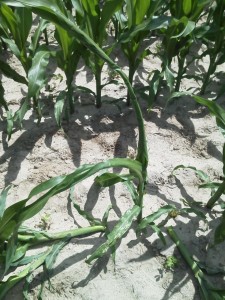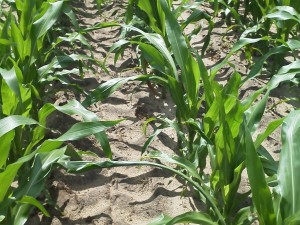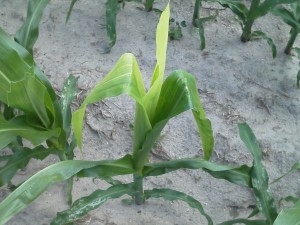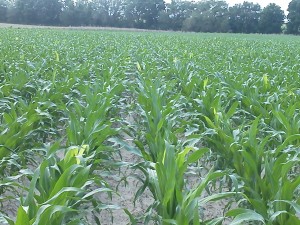Before you ask, YES, everyone from Missouri has a mule and wagon. So when corn gets a little twisted up it reminds us of a buggywhip. Because we grew up with a buggywhip either in our hand, or at our tail. However when you go the the Hoosier State, they call it Twisted Whorls…….
 I digress. Scouting a few area corn fields, every time I came to one planted to a particular hybrid, I could find what I call “buggywhip.” A little later in the week, a farmer called and said he must have some “off-type” corn seed. He was seeing the yellow flagging in the field that is a characteristic of this. I was prepared to let this issue rest until we got into another period of cold wet weather. I expect a few more calls in the near future.
I digress. Scouting a few area corn fields, every time I came to one planted to a particular hybrid, I could find what I call “buggywhip.” A little later in the week, a farmer called and said he must have some “off-type” corn seed. He was seeing the yellow flagging in the field that is a characteristic of this. I was prepared to let this issue rest until we got into another period of cold wet weather. I expect a few more calls in the near future.
For supporting literature, I refer you to Dr. Corn himself, Dr. Bob Nielsen at Purdue University.”The curious phenomenon often referred to as the ‘twisted whorl syndrome’ often occurs when young corn shifts quickly from weeks of slow development (cool, cloudy weather) to rapid development (warm, sunny weather).”
http://www.agry.purdue.edu/ext/corn/news/timeless/TwistedWhorls.html
I was 4 for 4 finding this in fields I knew planted to this hybrid. I suspect others in our area will be finding this with the current round of cool temps, and the warming trend. One of our seed company agronomists said they most often see it in their fastest growing hybrids. It seems that all we are growing is these “racehorse” hybrids now, so I think some of the other hybrids will probably show this also. All of these photos were taken on 4/28/13.

“I will freely admit that we do not fully understand why this symptom develops. For some reason, the leaves of the whorl of affected plants do not unfurl properly, as if the rolled leaf tissue has lost its elasticity or has become “sticky”. Younger leaves developing deeper in the whorl are unable to emerge through the tightly wrapped upper leaves. The subsequently tightly twisted whorl then bends and kinks from the pressure exerted from the younger leaves’ continued growth.” Dr. Bob Nielsen



Pingback: Buggywhipping in Corn « Seminole Crop E News